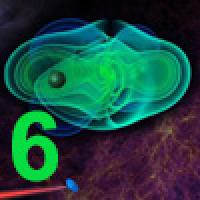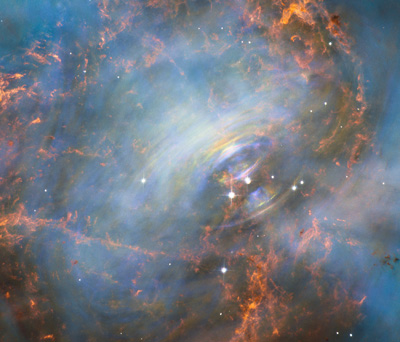
Plus Advent Calendar Door #6:New windows on the Universe
As we found out with door #4 and door #5 of our advent calendar, gravitational waves were first discovered in 2015 after a heroic effort by scientists to build the detectors and get the theory into shape. But why are these ripples in spacetime so important?
An extra sense
But why do we even want to detect all those gravitational waves? The answer is that they will act as a sort of additional sense with which to explore the Universe. In ordinary life we explore much of the world around us through sight and sound. Both of these involve waves: light, that is, electromagnetic radiation, and sound waves. In a similar way gravitational waves can tell us a lot about the objects and events that caused them.

Neutron star say cheese: This image from the Hubble space telescope shows the very heart of the Crab Nebula including the central neutron star — it is the rightmost of the two bright stars near the centre of this image. Image: NASA, ESA.
To really understand the world around us, it's best to look and listen. The same goes for understanding the Universe. One thing physicists are hoping to do soon is to observe gravitational waves caused by the collision and merger of two neutron stars. "A merger of neutron stars will also produce electromagnetic waves; X-rays and gamma rays that can be seen by telescopes" says Gabriela González, Professor of Physics and Astronomy at Louisiana State University and former Spokesperson of the LIGO Scientific Collaboration. "The different signals are produced by different features of the system: the gravitational waves by the motion of the masses, the electromagnetic waves by electrons. [By observing them both] you can tell what everything [about the neutron stars] is doing."
This multi-messenger astronomy, as it's called, can tell us a number of things about neutron stars: whether they form a black hole or another type of star when they merge, for example, or how matter within a neutron star is arranged. The same goes for any other event that causes both electromagnetic radiation and gravitational waves. Having more than one tool to explore it will give us a better picture.
Black holes
But the big players in the area remain black holes. Until gravitational waves coming from the mergers of black holes were detected, physicists weren't even sure black holes really existed. They were predicted by Einstein's general theory of relativity, but there was only indirect evidence for them. And even now, there is still much to learn about them.
"There are many things we would like to find out," says Chris Moore a physicist at the University of Cambridge. "Are heavy black holes more common than light black holes? Does the number of black hole mergers change as the Universe gets older?" A catalogue of gravitational wave detections will help answer these questions. In fact, two of the three detections made so far involve black holes that are more massive than was expected, suggesting the population of massive black holes might be larger than was at first thought.
But it's not all about size. There are other features of black holes that come out of the theory, but which we haven't so far been able to check in reality. A very nice example involves their surprising lack of complexity. A body like our Earth is hugely complex: it has an atmosphere, mountains and oceans, vegetation, animals and people. All the world's libraries and the internet taken together don't contain a complete description of it. Now imagine compressing the Earth into a small volume of space so that it turns into a black hole. Then that black hole would be described by just two pieces of information: its mass and the rate at which it is spinning. At least that's what the theory suggests, as people like Stephen Hawking have shown.

This is an artist's impression of a black hole. Image: NASA.
The idea that black holes are so staggeringly simple has become known as the no hair hypothesis: the black holes we find in nature are shorn of all complexity and can be described only by their mass and spin. They are bald.
The hypothesis can be explored using gravitational waves. If black holes have no hair, then the curvature of spacetime that comes with them is only determined by their masses and spins. "LISA will be able to study gigantic black holes that weigh millions of times of what the Sun weights," says Kip Thorne, one of the main players in gravitational wave theory and recipient of the 2017 Nobel Prize in Physics (see the video below).
"If you have a small black hole of, say 10 solar masses, going around a black hole of, say, a million solar masses, then the small black hole basically samples all the space around the big black hole. It turns out that the gravity wave signal from that motion carries a full map of the spacetime geometry of the big black hole." Thus, gravitational waves will be able to tell whether the spacetime around the big black hole agrees with what the no hair hypothesis predicts.
The birth of the Universe
The reason why most cosmologists today agree that the Universe was born in a Big Bang nearly 14 billion years ago is that we have a baby picture of it. The cosmic microwave background (CMB) consists of electromagnetic radiation that has travelled to us from a time when the Universe was only 380,000 years old, and it tells us a lot about what it was like back then. Before that time, the Universe was too dense and hot for electromagnetic waves to get through, so we can't hope for an earlier electromagnetic image of the Universe.
Gravitational waves, however, are different. "Gravitational waves are the only form of radiation that's so penetrating that it could be produced in the Big Bang explosion itself, in the so-called Planck era, and travelled almost unscathed by absorption, re-emission and scattering by matter in the intervening time," says Thorne. Gravitational waves can help us glimpse the very first moments of the Universe, a time at which accepted physical theories break down. Nobody knows what really happened back then.
"The best bet for [detecting gravitational waves from the very early Universe] is to measure the polarisation of the CMB," explains González. "It turns out that gravitational waves that existed even before the CMB waves were emitted would change the polarisation of the photons [that make up the CMB radiation]." We will look at CMB polarisation in detail in a future article — suffice to say that polarisation patterns should serve as fingerprints of very early gravitational waves in the CMB radiation, which can be measured.
What exactly those primordial gravitational waves will tell us is any physicist's educated guess. A particularly exciting prospect concerns the birth of the fundamental forces of nature. In another triumph of theoretical physics, scientists in the 1960s devised a theory which said that two of those forces, the electromagnetic force and the weak nuclear force, were once one and the same and only split apart as the Universe cooled down from the Big Bang. The theory was confirmed by the discovery of particular kinds of particles in particle accelerators — the famous Higgs boson has a hand in this too (see here to find out more). Gravitational waves might tell us more about the moment the forces split, in the very first moments after the Big Bang. This might even give a tantalising hint towards one of physicists' greatest dreams: to develop a great unified theory that describes all forces in one unified mathematical framework.
But what would excite physicists most would be the discovery of something completely unexpected — whether it involves black holes, the Big Bang, or something entirely new. Thorne believes that gravitational waves will deliver. "At some point there will be some giant surprises," he says. "But I can't tell you when and I can't tell you what."
This article is a condensed version of New windows on the Universe, which is partly based on a lecture by Nobel Laureate Kip Thorne and an interview with Gabriela González. You can see both below.
Gabriela González explains gravitational waves.
Kip Thorne's Andrew Chamblin Memorial Lecture on gravitational waves.
This year's advent calendar was inspired by our work on the documentary series, Universe Unravelled, which explores the work done by researchers at the Stephen Hawking Centre for Theoretical Cosmology and is available on discovery+. Return to the 2020 Plus Advent Calendar.